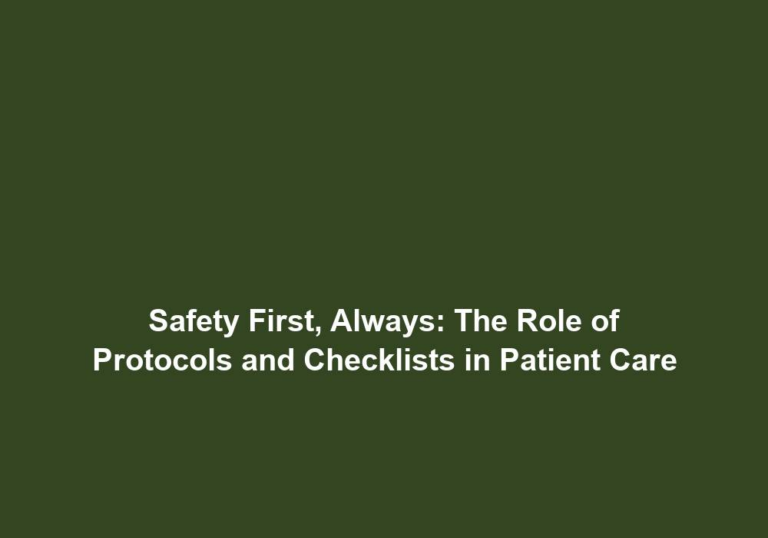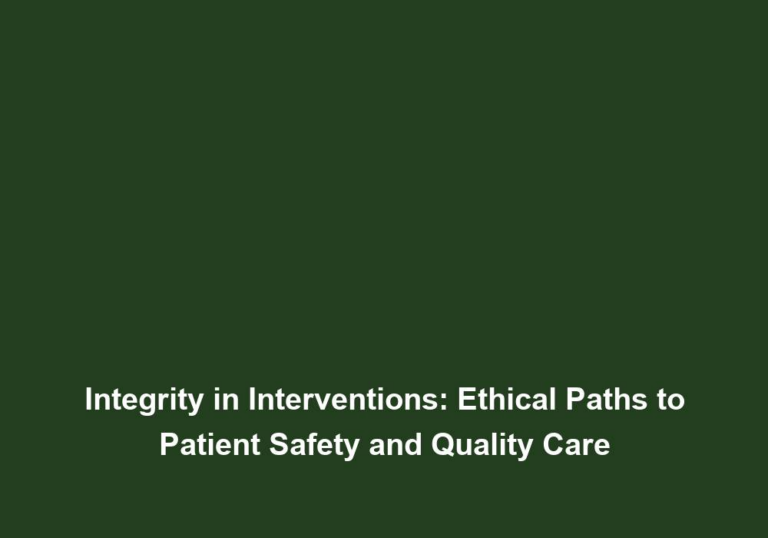Striving for Excellence: The Role of Continuous Quality Improvement in Patient Safety
In the healthcare industry, ensuring patient safety is of paramount importance. It is vital for healthcare organizations to strive for excellence and continuously improve their quality of care. This article explores the role of continuous quality improvement (CQI) in enhancing patient safety, along with its benefits and implementation strategies.
Understanding Continuous Quality Improvement (CQI)
Continuous Quality Improvement refers to an ongoing process that aims to improve the quality of healthcare services provided to patients. It involves a systematic approach that identifies areas for improvement, implements interventions, and evaluates their effectiveness. CQI focuses on enhancing patient outcomes, promoting patient safety, and optimizing the delivery of healthcare services.
Continuous Quality Improvement can be achieved through the following steps:
-
Identification and Mitigation of Risks: CQI enables healthcare organizations to identify potential risks and hazards in patient care processes. By analyzing data, conducting root cause analyses, and implementing appropriate interventions, risks can be mitigated, minimizing the chances of adverse events and promoting patient safety. This includes identifying medication errors, surgical complications, and other factors that may contribute to patient harm.
-
Optimization of Processes: Through CQI, healthcare organizations can streamline their processes, eliminating inefficiencies and reducing errors. This optimization not only improves patient safety but also enhances the overall quality of care by ensuring timely and effective delivery of services. For example, implementing standardized protocols and guidelines can help reduce variations in care and improve patient outcomes.
-
Promotion of a Culture of Safety: CQI fosters a culture of safety within healthcare organizations. It encourages open communication, transparency, and collaboration among healthcare professionals, creating an environment where errors can be reported, analyzed, and prevented in the future. This culture of safety enhances patient safety by promoting a proactive approach towards identifying and addressing potential risks. It also includes promoting a non-punitive approach to reporting errors, encouraging staff to share their experiences and learn from them.
-
Improved Patient Outcomes: By continuously striving for excellence through CQI, healthcare organizations can significantly improve patient outcomes. The identification and implementation of evidence-based practices, along with the reduction of errors, contribute to better patient outcomes, increased patient satisfaction, and reduced healthcare costs. For instance, adopting best practices for infection control can help prevent healthcare-associated infections and improve patient recovery rates.
Implementing CQI in Healthcare Organizations
Implementing Continuous Quality Improvement requires a systematic and structured approach. Below are some key steps and strategies for successfully implementing CQI in healthcare organizations:
Step 1: Establishing a CQI Team
Forming a multidisciplinary team dedicated to CQI initiatives is crucial. This team should include representatives from various departments and disciplines, including physicians, nurses, quality improvement specialists, and administrators. The team will be responsible for leading and coordinating CQI efforts within the organization. By bringing together diverse perspectives and expertise, the team can effectively identify and address areas for improvement.
Step 2: Data Collection and Analysis
Collecting and analyzing data is essential for identifying areas requiring improvement. Healthcare organizations should establish mechanisms to collect relevant data, such as patient outcomes, adverse events, and near misses. Analyzing this data allows for the identification of trends, patterns, and areas of concern, which can then be addressed through appropriate interventions. By utilizing data-driven insights, organizations can make informed decisions to enhance patient safety and quality of care.
Step 3: Setting Goals and Objectives
Based on the data analysis, the CQI team should set measurable goals and objectives. These goals should be specific, achievable, and aligned with the organization’s mission and vision. Examples of goals in the context of patient safety may include reducing medication errors, decreasing hospital-acquired infections, or improving patient satisfaction scores. Setting clear goals helps provide direction and focus for the CQI initiatives.
Step 4: Implementation of Interventions
Once the goals and objectives are established, the CQI team should implement targeted interventions to address the identified areas for improvement. These interventions can include process changes, staff training and education, the adoption of evidence-based practices, and the implementation of technological solutions to enhance patient safety. By implementing evidence-based interventions, organizations can ensure that best practices are followed and potential risks are minimized.
Step 5: Evaluation and Monitoring
Regular evaluation and monitoring of the implemented interventions are essential to determine their effectiveness. The CQI team should establish performance indicators and metrics to assess progress towards the established goals. Ongoing monitoring enables the identification of any barriers or challenges and allows for timely adjustments and refinements to improve outcomes. By continuously evaluating the interventions, organizations can ensure that they are making meaningful improvements in patient safety and care quality.
Step 6: Continuous Learning and Improvement
CQI is an iterative process, and continuous learning is a key component. Healthcare organizations should encourage a culture of learning, where feedback is valued, and lessons learned from both successes and failures are shared. This continuous learning approach ensures that the organization remains adaptive, responsive, and continuously improves its practices and processes. By fostering a culture of continuous improvement, organizations can drive positive change and sustain high standards of patient safety and care quality.
Conclusion
Continuous Quality Improvement plays a vital role in enhancing patient safety within healthcare organizations. By fostering a culture of safety, optimizing processes, and implementing evidence-based interventions, CQI leads to improved patient outcomes, reduced risks, and increased overall quality of care. Implementing CQI requires a systematic approach, involving data collection and analysis, goal setting, interventions, evaluation, and continuous learning. By striving for excellence through CQI, healthcare organizations can ensure the highest standards of patient safety and quality of care.






